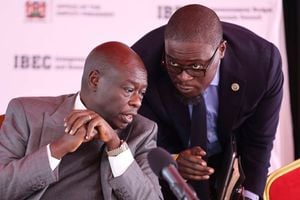Kenya and its multitude of hammer blows

The year-on-year inflation rate in Kenya stands at 7.9 percent as of June 2023.
Kenya is receiving a generous quantity of hammer blows that are testing the country both economically and socially. Worldwide and domestic inflation is persistently high and we are witnessing upward price pressures every day.
Prices are rocketing and one recent example is that of sugar which has shot up by over a third.
The cost of living is increasing in leaps and bounds but without the necessary upward movement in the economy. When one mirrors the recently released economic figures against the reality on the ground and in particular the surging inflation they actually paint a mixed and generally lackluster picture.
Let us look at some of the key indicators of Kenya’s economic well-being.
Inflation is at around 9 per cent, remains persistently high and could get into double digits. When one bears in mind high inflation around the world and especially for food-related items and factor that into the day-to-day running of the economy one can see how Kenyans are running to stand still.
Kenya is a major net food importer, especially in wheat, rice and sugar and in rain-deficient years also its staple food maize. Due to erratic and inadequate rains over the past few years, its dependence on imported food has grown and at a time when world food prices are exceptionally high.
Foreign exchange reserves are down by 15 per cent and represent three months of imports. This is arguably a knife-edge existence in the current precarious economic environment.
Domestic and international debt now exceeds 60 per cent of GDP which is high and arguably is in danger of rising further. September is a critical month as we have some large international payments to make.
One of the drivers of inflation is the fact that our heavily import-dependent economy is having to pay more shillings for the foreign currencies used to pay for our imports.
The shilling has dropped by over 13 per cent against the USD since the beginning of the year and the pressure on it to drop further is intense.
Another factor that is becoming increasingly prominent and fractious is the government’s hunger for whatever money it can get. An assortment of taxes and levies have been either raised or introduced. The latest is the housing levy which will be deducted from all salaried employees.
The said purpose of the levy is to enable the government to build affordable housing which in theory is commendable. But how much of this money will be spent on that is another thing. Government has a reputation for using more money on day-to-day operations and salaries and wages with precious little left over for capital projects.
There is also the fact that the more you tax the more you smother private enterprise and this government is going in that direction fast. It is a well-established fact that the more one increases taxes and other levies the more one risks holding back and slowing down commercial activity and the economy generally.
The crunchy economic times are going to get crunchier and the government needs to map out and implement a much bolder economic policy with arguably a stronger team. Failure to do so could risk the economy going off course very fast and inturn shrinking.
It goes without saying that the events of Shakahola are an important facet of the multidimensional hammering which Kenya is getting.
As with Covid-19 what took place there goes well beyond the confines of the actual event and has huge repercussions on and implications for the country as a whole.
The big question on the minds of many is how could such an enormous, disturbing, and indeed horrifying string of incidents have taken place over that period under the watch of the many arms and legs of officialdom?
A follow-up question is why weren’t such red flags raised by setups such as Muslim for Human Rights (MUHURI) and others get heeded? If the Red Cross, for example, is giving an estimate of the number of people unaccounted for then there must be a lot of information available.
To put it more bluntly how could multiple starvation, deaths, shallow graves and alleged organ harvesting all take place without investigation and without any impactful action from the relevant authorities?
Was this neglect or corruption or both? It certainly was not ignorance. Remember we are not talking about some petty offence. We are talking about hundreds of people starving, dying and being buried in shallow graves in this one area.
In short government has failed in one of its core, primary functions which is to look after and safeguard its citizens. Indeed it is the failure to implement one of the key tenets of upholding law and order.
This is very, very serious and we need to be rightfully concerned about the many implications for the country as a whole.
Remember the rule of law, its observance and implementation is the foundation of a nation-state and its economic well-being and indeed the economy as a whole.
As with Covid 19 the ripple effect of Shakakola on the country are many and enormous.
One of several is tourism. Kenya, and Malindi in particular, have featured frequently on news broadcasts around the world. It will be interesting to see how much this string of negative publicity affects our tourism industry at a time when we really need the latter.
In conclusion, the challenges facing Kenya should be viewed holistically which is why economic and social statistics should stand side by side with the horrors of Shakahola.
- Robert Shaw is a public policy and economic analyst:[email protected]





